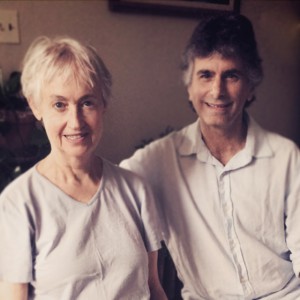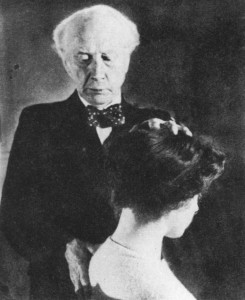A Hands-on Approach to Consciousness and Body Awareness
By Linnie Oysler

We all use excess tension in everything we do, whether sitting, standing, walking, dancing, playing a musical instrument, participating in sports, talking, or even just thinking. Mostly, we are not conscious that we are constricting and holding our bodies, that the tension is something we are actively “doing”. We often think gravity is pulling us down. Usually, when we become aware of feeling uncomfortable in our bodies (such as with neck, back, hip or knee pain) we attempt to make a change by doing what we think is right. We look for a more upright position, which itself soon becomes uncomfortable because we are using great effort in trying to maintain what we think is good posture. We all know how much work is involved in trying to hold ourselves up, but we don’t realize how much work we are doing in holding tension in our bodies, because it is something we have gradually increased throughout our lives.
Most of us are aware we use excess tension, but we have not learned to observe ourselves creating the tension.
Therefore our automatic or habitual response is to try to escape from the tension or pain by pushing ourselves into
what we think is right posture. That requires much effort, or more excess tension! Since our kinesthetic sense of
what we are doing is inaccurate and unreliable, and since we don’t know what it means to move without excess
tension, we are never successful in finding a comfortable position. It is only when we begin to be aware of the
effort involved in looking for a right position that we may experience true natural ease and freedom in all our
movements.
Our habits of misuse, which are due to our lack of awareness of the way we use ourselves, are very strong, and
ingrained on a deep unconscious level of our being. In order for any change to occur, we must realize and accept how
strong these habits are. We must learn to observe ourselves as we are, not as we think we should be, for when we are
striving to be something other than what we are, we are creating a separation within ourselves, and fighting against
life. When we fight, or struggle or resist, change cannot occur; we cannot live a harmonious life. But with
observing our tendency to judge ourselves and others, and with becoming aware of our resistance, or fear of not
being right, we can learn to see that we clench our jaw to talk, or play music or chop vegetables, and hold our
necks tight in everything we do. We can watch as we pull our chins and necks forward, or notice that we hold our
shoulders up, while at the same time we may press our upper body back and pull our shoulder blades together, from
years of trying to hold our posture right. We can learn to notice how our back feels when we throw our hips forward
or lock our knees. We can begin to move out of those positions and postures and into balance, which is movement, and
therefore can never be held.
We can learn to observe that we hold our breath; notice how shallowly we breathe, and that we push our breath
out while constricting our bodies. It is only when we learn to become aware of excess tension that we can allow the
breath to flow out, and it is only when our breath flows out that we can take a deep breath in.
We are all making choices all the time, and most of those choices are made unconsciously. We can learn to be
more conscious of the choices we make, as we make them. Through paying attention, we become aware that we are
actually creating and holding tension in our bodies, and when we see that we are in fact doing that, we will no
longer maintain those long-held habits of use that interfere with our natural freedom and ease. Through awareness we
can become familiar with our use of excess tension in our thoughts and movements, which brings ease in our whole
psycho-physical being.
 In a lesson or class, the teacher uses her hands to gently
interfere with long-held habits. By being guided out of those habits, the student begins to see what those habits
are, and to experience a new-found freedom and joy in what movement can feel like without the tension one usually
holds. While working with her hands, the teacher will discuss with the student what is taking place as it happens,
which allows the student to start the process of observation.
In a lesson or class, the teacher uses her hands to gently
interfere with long-held habits. By being guided out of those habits, the student begins to see what those habits
are, and to experience a new-found freedom and joy in what movement can feel like without the tension one usually
holds. While working with her hands, the teacher will discuss with the student what is taking place as it happens,
which allows the student to start the process of observation.
The teacher will guide students in learning to know where their joints actually are. As we learn to use our
joints more accurately, we experience greater range and freedom in our movements. With proper use of the joints we
can easier let go of holding excess tension in our muscles.
The result of this work is increased awareness and consciousness in every aspect of our lives. Students report
being more conscious in their relationships and interactions with others. They often notice that they are more
loving, and less reactive and judgmental of themselves and others, with less need to control their lives or
situations around them, as if these are separate from themselves.
Throughout our lives, we have all used a lot of effort, much more than we need, in everything we do. It doesn’t
really matter why that came about or where it came from, but it is important to accept that fact. When we begin to
accept, rather than deny, ignore, or resist that, then we begin the process of waking up to living more in the
present moment. We will notice whether we hold our toothbrushes or pens too tight, our necks too tight, or onto our
positions of thinking we are right in our ideas, judgments and beliefs. In being aware of our habits of thinking and
body use, we become more graceful, poised, and fluid in all our movements.
We become more vulnerable and less held and rigid as we no longer hold onto our self-protection and our fight
against life. We open ourselves to giving more generously and receiving all the gifts of the universe. We begin to
experience tremendous feelings of inner power and strength as we become aware of body tensions, along with limiting
and held beliefs. We become conscious of negative words, thoughts, expressions, and attitudes that interfere with
our freedom and wholeness, and out of that awareness, we no longer choose separation. We realize unlimited
possibilities for abiding joy and love that come through acceptance of all opportunities life gives us for our
growth and evolution, without attachment to the way we think we want life to be.
We live more in balance, in harmony with the way the universe works. We feel happy and joyous as we begin to
spend more time in present moment awareness and less time in the past and future.
In the beginning, students may ask if it is all right to feel so alive in their bodies, their whole
psycho-physical being, but soon they embrace those joyous feelings, those feelings of well-being. They may say they
feel like dancing, or wish they could share what they feel with everyone they know.
This is about learning to think in a new way, through observation, rather than concentration. It is about
expanding our awareness to include what we are doing with ourselves while doing all the things we normally do in our
daily lives. It is about learning to give up all the effort that has never helped us in the first place, and it is
about giving up any attachment to thinking we ever know what “right” is, for when we think we know what “right” is,
we close the door to learning. It is only when we put away any ideas of what something is, any ideas of thinking we
are right, or trying to be right, that truth reveals itself to us in all its simplicity.